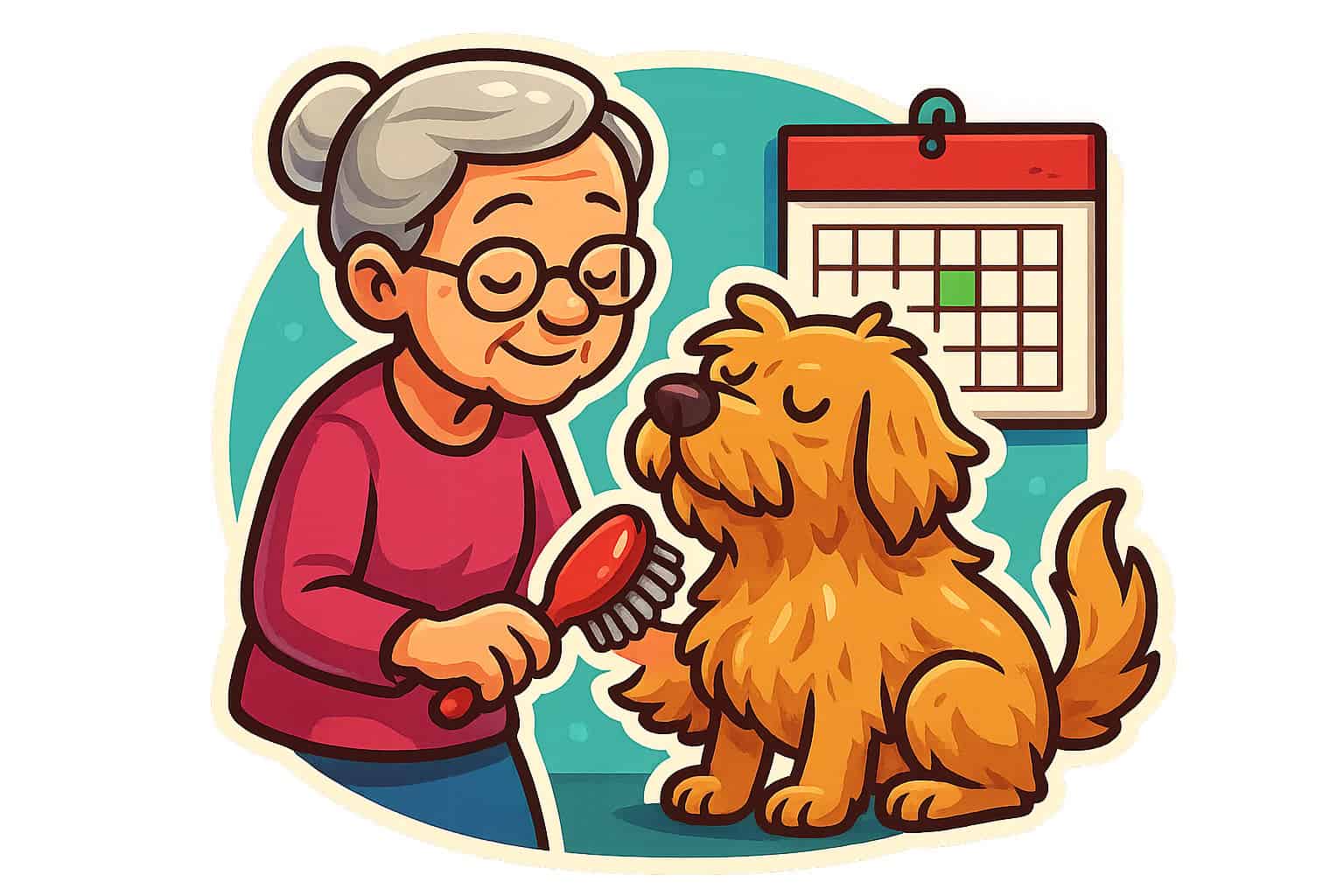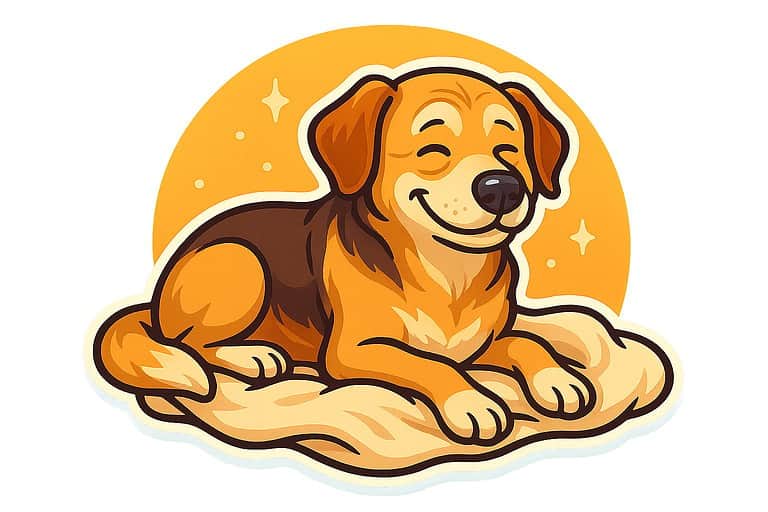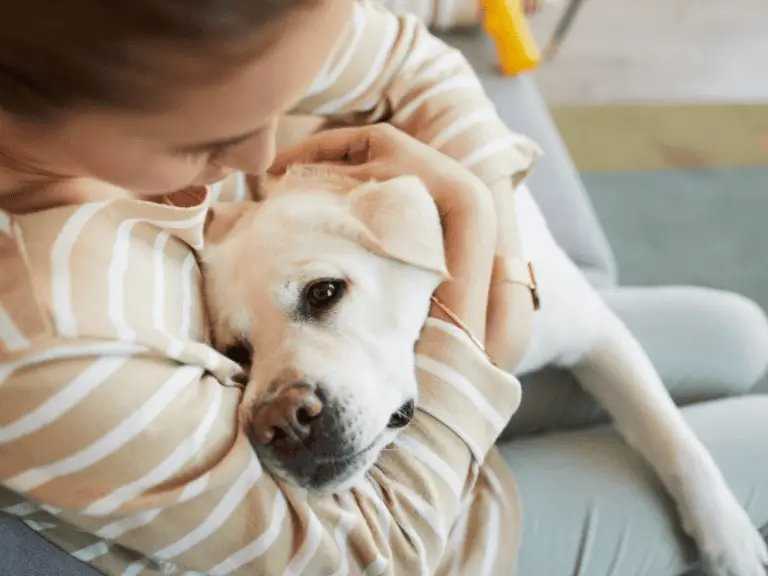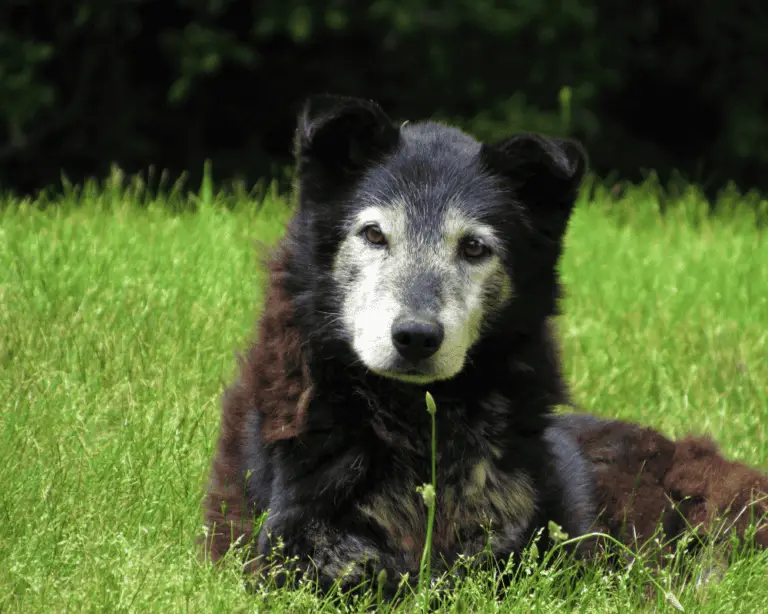How Often Should I Brush My Older Dog?

Your senior dog’s graying muzzle and slower pace might make you wonder if their grooming needs have changed too.
Just like us, older dogs face new challenges as they age, from achy joints to sensitive skin. Their brushing routine should adapt accordingly.
Most senior dogs need brushing 2-3 times per week. Dogs with longer coats may need daily attention, while shorter-haired breeds might only need weekly brushing.
The main thing? Be gentler and more patient than you were when they were younger.
Getting the frequency and technique right really matters for keeping your older companion comfortable and healthy.
You’ll find out how to choose the right tools, notice when your dog needs extra care, and turn brushing into a soothing bonding experience instead of a stressful chore.
Why Brushing Matters for Senior Dogs
Regular brushing becomes even more important as your dog ages. It helps prevent painful matting and skin problems that senior dogs face more often.
Brushing also gives you a chance to spot health changes early, when treatment is most effective.
Your senior dog’s skin gets more sensitive and fragile as they age. Regular brushing spreads natural oils through their coat, keeping skin healthy and comfortable.
Matting becomes a bigger problem for older dogs who can’t groom themselves as well. When hair mats, it pulls on sensitive skin and can cause painful sores underneath.
Brushing also helps you bond with your dog. Many senior dogs actually enjoy the gentle attention, especially if they’re less active than before.
Aging Changes Your Dog’s Coat and Skin
Maybe you’ve noticed your dog’s coat looks different than it used to?
Senior dogs often develop thinner, more brittle hair that tangles easier. Their skin becomes thinner and less elastic, so it tears more easily and heals slower than when they were young.
Common coat changes include:
- Hair becomes thinner or patchy
- Coat feels more coarse or dry
- Gray hairs appear (just like us!)
- Hair mats faster than before
Your dog might struggle to reach certain spots to clean themselves. Stiff joints make it tough to twist around and groom their back end or legs.
Spot Health Issues While Brushing
Brushing time is perfect for checking your senior dog’s body for new lumps, bumps, or skin problems. Your hands can find things your eyes might miss.
What to look for while brushing:
- New lumps or bumps under the skin
- Red, irritated, or flaky skin patches
- Hot spots or areas that feel warm
- Cuts, scrapes, or sores
- Unusual smells
If your dog suddenly doesn’t want to be brushed in certain areas, they might feel pain there. Senior dogs often hide discomfort well.
I recommend keeping notes about what you find during brushing sessions. This helps you track changes and gives your vet useful information.
Pay extra attention to areas your dog can’t reach easily, like their back and rear legs. These spots often develop problems first in senior dogs.
How Often Should I Brush My Older Dog?
The frequency depends on their coat type, activity level, and seasonal shedding patterns. You’ll need to be more gentle and patient than before.
Guidelines for Different Coat Types
Short-haired breeds like Beagles or Labs need brushing 1-2 times per week.
Your older dog’s skin becomes more sensitive with age, so use a soft bristle brush or rubber grooming mitt. These tools remove loose hair gently.
Medium-coated dogs such as Golden Retrievers require brushing every other day.
Their double coats can mat easily, especially if your senior pup is less active. Focus on spots that mat quickly: behind the ears, under the legs, and around the tail.
Check these areas daily even if you don’t do a full brushing session.
Long-haired breeds like Afghans or Yorkies need daily brushing.
I know this sounds like a lot, but it can be quality bonding time. Start with a slicker brush for tangles, then use a pin brush.
If your dog has arthritis or joint pain, keep sessions short maybe 10-15 minutes at a time.
Consider Your Dog’s Activity Level
Has your senior dog become more of a couch potato?
Less active dogs actually need more frequent brushing, not less. When dogs don’t move around much, their natural oils don’t distribute evenly through their coat. Dead hair also stays put instead of falling out during play and walks.
If your dog still enjoys daily walks and playtime, you can stick closer to the standard brushing schedule for their coat type. Active seniors naturally shed loose hair during movement.
Indoor dogs need extra attention too. Without outdoor adventures to naturally remove loose fur, indoor seniors can develop more mats and tangles.
Seasonal Changes and Shedding
Your senior dog still experiences seasonal shedding, though it might be less dramatic than when they were younger.
Spring and fall remain the heaviest shedding times. During shedding season, increase brushing frequency by about 50%.
If you normally brush twice a week, bump it up to every other day.
Should you notice excessive shedding outside of normal seasonal patterns? This could indicate health issues like thyroid problems or skin conditions.
Winter months often bring drier air, which can make your senior’s skin more sensitive. Use a brush with softer bristles and consider a moisturizing spray designed for dogs.
Summer heat can make your older dog uncomfortable during grooming sessions. Try brushing in the cooler morning or evening hours when they’re more patient.
What to Do When Your Dog Resists Brushing
Does your once-cooperative dog now squirm or snap during brushing?
This resistance often comes from new aches and pains, not stubbornness. Start slowly with just a few gentle strokes.
If your dog seems uncomfortable, stop and try again later. Forcing the issue only makes future sessions harder.
Maybe your dog has developed arthritis? Lying down for grooming might hurt their joints. Try brushing while they’re standing or sitting instead. Use high-value treats throughout the session.
I recommend having someone else feed treats while you brush, if possible.
Break brushing into multiple short sessions rather than one long one. Five minutes twice a day works better than 10 minutes of struggling.
If your dog continues to resist, talk to your vet. They can check for painful areas and suggest solutions.
Choose the Right Brush for Senior Dogs
Senior dogs need gentler brushes than younger dogs because their skin becomes more sensitive with age.
The right brush can make grooming a pleasant experience, while the wrong one might cause discomfort or even pain.
Types of Brushes and Their Benefits
Slicker brushes with soft pins work well for most senior dogs with medium to long coats.
Look for brushes labeled as „gentle“ or „soft.“ These remove loose fur without scratching sensitive skin.
Pin brushes are perfect if your older dog has a thick or fluffy coat. Choose ones with rounded tips on the pins.
They detangle gently and feel more like a massage than harsh brushing.
Bristle brushes suit senior dogs with short, smooth coats best. Natural bristles distribute oils through the fur and feel comfortable on aging skin.
They’re also great for dogs who get anxious during grooming.
Rubber curry brushes offer the gentlest option for very sensitive seniors. They remove loose hair while giving your dog a soothing massage.
Many older dogs actually enjoy this type of brushing.
Have you noticed your dog pulling away during brushing? Try switching to a softer brush before assuming they just don’t like being groomed.
Brushes to Avoid With Sensitive Skin
Metal slicker brushes with sharp pins can scratch and irritate your senior dog’s delicate skin.
These might have worked when your dog was younger, but aging skin needs gentler care.
Undercoat rakes and shedding tools with metal teeth often pull too hard on sensitive skin.
While effective for heavy shedding, they can cause discomfort or even small cuts on older dogs.
Stiff wire brushes should stay off your shopping list entirely.
Your senior dog’s skin has likely thinned with age, making these brushes too harsh for regular use.
If your dog shows signs of discomfort like pulling away, whining, or red skin after brushing, the brush is probably too rough.
Switch to something gentler right away.
Step-By-Step Brushing Routine for Older Dogs
Senior dogs need extra care and patience during grooming sessions.
Creating a calm environment and checking thoroughly for problem areas will keep your older dog comfortable and healthy.
Make Brushing Relaxing and Fun
Start by choosing a quiet spot where your senior dog feels safe.
Maybe it’s their favorite corner of the living room or that sunny spot by the window they love.
Keep these supplies nearby:
- Soft-bristled brush or slicker brush
- Treats for rewards
- A towel if your dog gets anxious
- Good lighting to see what you’re doing
Begin each session with gentle pets and calm words.
Your dog can sense your mood, so stay relaxed yourself.
Start with short 5-minute sessions if your dog seems uncomfortable.
You can always build up to longer grooming times as they get used to it.
Reward good behavior immediately.
Give treats and praise when your dog stays still or seems calm during brushing.
If your dog has arthritis or joint pain, let them lie down instead of standing.
Some senior dogs get tired quickly, and that’s perfectly normal.
Talk to your dog throughout the process.
Your voice will help keep them calm and make the experience feel more like bonding time than a chore.
Check for Tangles and Mats
Senior dogs often develop mats more easily because they groom themselves less.
Their skin also becomes more sensitive with age, so you need to be extra gentle.
Look for these problem areas first:
- Behind the ears
- Under the legs and belly
- Around the tail and rear end
- Areas where collars or harnesses rub
Feel with your hands before you brush.
This helps you find mats or sore spots your dog might have.
For small tangles, work them out slowly with your fingers first.
Use a detangling spray if needed, but test it on a small area first to make sure it doesn’t irritate your dog’s skin.
Never pull or yank at mats.
If you find a large mat, use a mat splitter or dematting tool.
Work from the outside of the mat toward the skin, taking small sections at a time.
Watch your dog’s face while you work.
If they seem uncomfortable or try to move away, take a break or switch to a different area.
Some mats are too tight or close to the skin to remove safely at home.
Don’t be afraid to leave these for a professional groomer.
When to Tackle a Full Groom
You don’t need to do everything in one session, especially with senior dogs.
Their attention span and comfort level might be shorter than when they were younger.
Signs your dog needs a break:
- Panting or drooling excessively
- Trying to walk away repeatedly
- Trembling or showing signs of stress
- Getting snappy or irritated
Plan full grooming sessions for when your dog has the most energy.
For many senior dogs, this is mid-morning after they’ve had breakfast and a short walk.
If your dog takes medication for pain or anxiety, time your grooming session when the medication is most effective.
Break the full groom into stages:
- Day 1: Brush the body and legs
- Day 2: Work on the head, ears, and tail
- Day 3: Handle nail trimming or other tasks
Some senior dogs do better with professional groomers who have experience with older dogs.
They have specialized equipment and techniques that can make the process easier and more comfortable.
Trust your instincts about what your dog can handle.
You know them better than anyone else, and their comfort should always come first.
Recognize Skin and Coat Problems
Senior dogs face unique skin challenges as their immune systems weaken and their skin becomes more sensitive with age.
Knowing what warning signs to watch for and when professional help is needed can help keep your older companion comfortable.
Signs of Dryness, Dandruff, or Irritation
Maybe you’ve noticed your senior dog scratching more than usual lately? This could be your first clue that something’s changing with their skin health.
Dry skin shows up as white flakes in your dog’s coat, similar to human dandruff. You might see these flakes on their bedding or notice them when you pet your dog.
Itching and scratching become more frequent when skin problems develop. Your dog might scratch, lick, or bite at specific areas repeatedly. Watch for red marks or sore spots from excessive scratching.
Changes in coat texture are common in older dogs. Their fur might feel rougher, thinner, or lose its natural shine. Some dogs develop bald patches or notice their coat color changing.
Skin irritation appears as red, inflamed areas. You might see bumps, rashes, or areas where the skin looks angry and inflamed. These spots often feel warm to the touch.
Does your dog’s skin smell different than usual? Skin infections can create unusual odors that weren’t there before.
When Should You Call Your Veterinarian?
If your dog keeps scratching for more than a few days, pick up the phone and call your vet. Senior dogs have weaker immune systems, so they’re more likely to get skin infections.
Go to the vet right away if you see open wounds, bleeding from scratching, or your dog yelps when you touch certain spots. These aren’t just dry skin problems anymore.
Patchy hair loss or sudden changes in coat thickness need a professional look. Sure, a bit of thinning comes with age, but big changes usually mean something’s wrong.
Watch for behavioral shifts like restlessness, skipping meals, or not wanting to be touched. These can mean your dog’s skin issues are really bothering them.
If gentle moisturizing shampoos or home remedies don’t help after a week, let your vet check for allergies, infections, or other medical problems.
Common Mistakes to Avoid
Brushing too hard tops the list of mistakes with senior dogs. Their skin gets thinner and more sensitive as they age, much like ours.
Using the wrong brush turns grooming into a chore for both of you. Hard bristles or metal brushes might’ve worked before, but now your dog needs something softer.
Rushing through brushing often tugs at their hair and causes discomfort. Older dogs need extra time to move, especially if their joints feel stiff.
Don’t ignore signs of pain or stress. If your dog pulls away, pants, or whimpers, you’re probably brushing too roughly.
Some of the most common brushing mistakes include:
- Brushing against the direction of the fur
- Yanking through mats instead of gently working them out
- Skipping tricky spots
- Using human brushes instead of ones made for dogs
- Not checking for lumps or bumps while brushing
Making your dog stand the whole time? That’s another common misstep. If lying down is easier for them, let them relax.
Brushing wet or damp fur usually leads to more tangles and discomfort. Always wait until your dog’s coat is totally dry.
Maybe your dog gets more anxious during grooming sessions? That often happens because we accidentally hurt them before. Take it slow and let your dog set the pace.
Tips for Dogs With Mobility or Health Challenges
Senior dogs with arthritis or other health concerns need some extra TLC during grooming. Adjust your approach and pick gentler tools to keep your older buddy comfy.
Brushing Techniques for Arthritic Dogs
Does your dog act stiff when you brush their back legs? Arthritis hits up to 80% of dogs over eight, so you’re definitely not alone.
Support their body as you brush. Try placing one hand under their chest or belly to take pressure off sore joints. This little trick can make a big difference for dogs with hip or spine pain.
Break grooming into shorter sessions. Instead of one long brushing marathon, try three five-minute sessions throughout the day. Those breaks really help.
Let your dog stay in whatever position feels best. If they want to lie on their side on something soft, go for it. Some dogs prefer standing on a non-slip mat.
Brush in the direction that feels most comfortable for them. Start gently and watch their body language. If they lean away from an area, it’s probably tender.
Warm up stiff muscles first. A warm towel on sore spots for a few minutes before brushing can help ease discomfort.
Gentle Grooming Tools for Sensitive Seniors
The wrong brush can make grooming miserable for older dogs. Tool choice matters more than ever now.
Soft-bristle brushes are usually the best bet for sensitive skin. Natural boar bristles or rubber grooming mitts feel more like a massage than a scratch.
Skip metal tools unless you really need them. Pin brushes and slicker brushes can irritate that thin, aging skin.
Some senior-friendly options:
- Silicone brushes that flex with your dog’s body
- Grooming gloves so you can brush while petting
- Wide-toothed combs for gentle detangling
- Microfiber cloths for quick touch-ups
Pick tools with comfy, ergonomic handles. Your hands will thank you if you’re spending more time being gentle.
Test new tools on a small patch first. See how your dog reacts before you go all in.
Nutrition and Hydration Changes Your Dog’s Coat
Your dog’s coat says a lot about their health. If your own hair looks dull when you’re not feeling great, it’s the same story for your senior dog’s fur.
Water is basically your dog’s secret weapon for a nice coat. When older dogs don’t drink enough, their skin dries out and flakes. That makes fur look rough and feel brittle.
A lot of senior dogs just don’t drink as much. Maybe you’ve noticed yours ignoring the water bowl lately?
Nutrients are the building blocks for healthy fur. Protein helps grow strong hair, and healthy fats keep it shiny and soft.
| Essential Nutrients | What They Do |
|---|---|
| Protein | Builds strong hair follicles |
| Omega fatty acids | Add shine and reduce dryness |
| Vitamins A & E | Support skin health |
If your dog’s missing these nutrients, you’ll see it in their coat first. Fur might look dull, thin out, or start falling out more than usual.
Older dogs show signs of poor nutrition faster than younger ones. Their bodies just can’t absorb nutrients as well anymore.
Try adding fresh water sources around the house. Some dogs drink more if you use a pet fountain. Worth a shot if your dog turns up their nose at the bowl.
Quality senior dog foods usually have extra fatty acids and protein. These help your aging pup keep that soft, healthy coat you love to snuggle.
How to Add Brushing to Your Senior Dog’s Routine
Brushing your older dog every day takes some patience and a little planning. Your senior pup might not love it at first, especially if they’re dealing with joint pain or stiffness.
Start slow and keep sessions short. Maybe you’ve noticed your dog gets tired more easily now? That’s totally normal. Try just 5-10 minutes of gentle brushing to begin.
Pick the same time each day for brushing. Dogs really do love routine. Your senior dog will feel more at ease when they know what’s coming.
Many owners like these timing options:
- Morning brushing – when your dog is rested
- After dinner – when they’re calm and relaxed
- Before bedtime – as part of winding down
Choose a comfortable spot where your dog can lie down if they want. A soft blanket or their favorite bed works well. If your dog struggles to stand, just let them rest during brushing.
Be gentle around sore spots. Senior dogs often have sensitive areas near their hips, spine, or joints. Watch your dog’s body language and ease up if they look uncomfortable.
Give treats and plenty of praise throughout the session. That way, brushing time starts to feel like a good thing.
If your dog seems anxious or just not into it, try brushing for only a few strokes at first. You can slowly add more time as they get used to it. Honestly, even a little brushing is better than skipping it when it comes to keeping your senior dog’s coat healthy.






